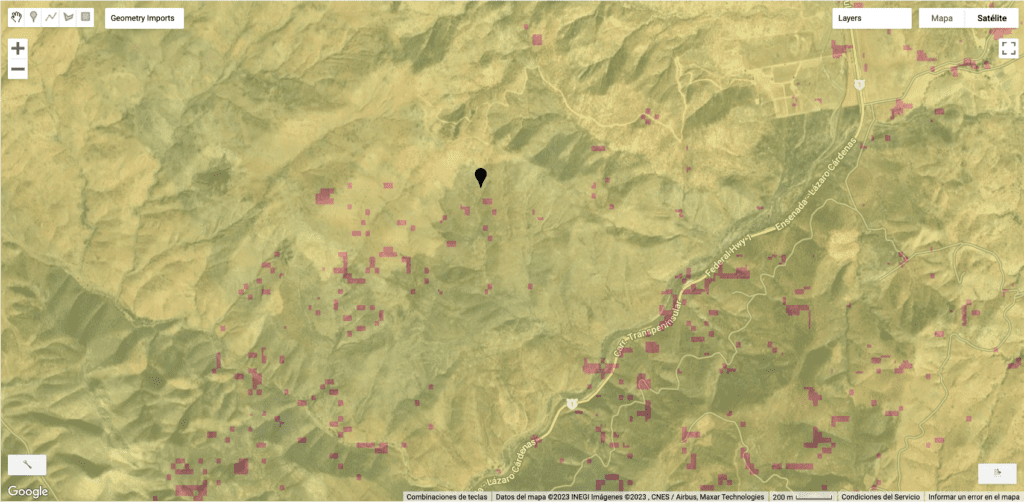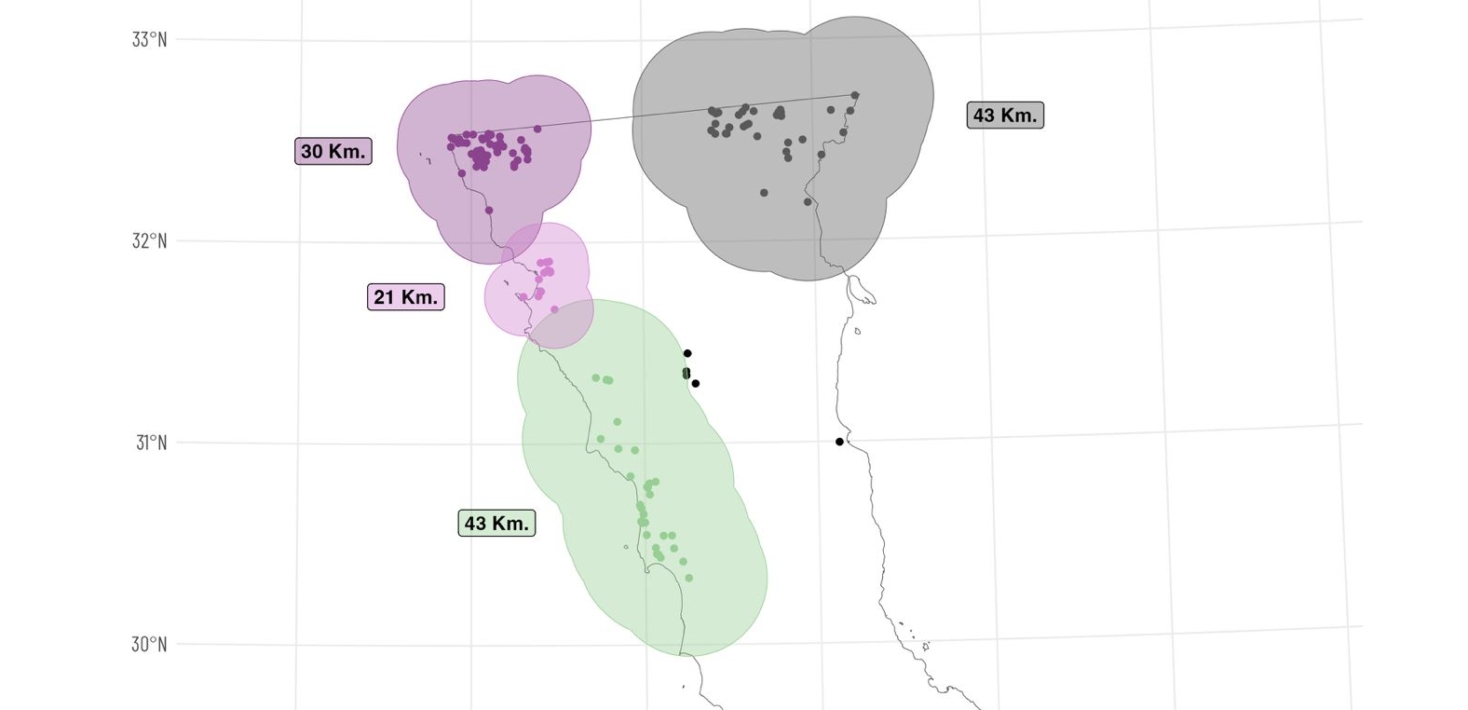Haga clic aquí para leer la publicación del blog en español.
In June 2022, Data Cívica, Elementa DDHH, the Human Rights Center of Universidad Iberoamericana and Centro Geo published, with Amnesty International’s Crisis Evidence Lab, the results of a new approach to support the search of clandestine graves in Mexico using geospatial technologies. We developed this tool to support search efforts for missing persons within the context of widespread disappearances in Mexico that have originated since 2007, due to the use of armed forces to counter alleged drug-related activities in the country.
With this methodology, we could delimit potential search areas in the northwestern state of Baja California. We employed a three-layered methodology, starting with Point Pattern Analysis of 52 georeferenced graves, revealing clustering patterns that suggested non-random site selection by perpetrators. The second layer involved spatial accessibility and visibility analysis, identifying 41 of 52 training data points located in what we conceptualized as clandestine spaces, characterized by high car accessibility and low visibility. Additionally, a novel hyperspectral analysis, monitoring plant chlorophyll concentration through the Nitrogen Accumulation Index (NAI) from satellite images, was introduced to detect changes in vegetation associated with decomposing bodies, with testing on known graves in Baja California. The original blog post can be found here.
This follow-up will highlight new results and the successful impact of the tool we developed, one year after publishing our initial results.
New results and impact of our model
Updated data
The state of Baja California has been one of the most affected in the country. A year after publishing our initial results, the cases of disappearances have continued to increase in the state. There are 17,306 cases of disappearances, according to figures from the Attorney General of the State of Baja California (FGEBC in Spanish). This figure represents an increase of 44.22% since our last post.
One year after publishing our first results, we can state that, unfortunately, the phenomenon remains recurrent in Baja California. We obtained new data on clandestine graves from freedom of information requests conducted to FGEBC to train our model and delimit further the potential search areas. We replicated our analysis with 160 verified points to avoid duplicates or imprecise locations. This meant that we identified 108 new points of graves observed by authorities between 2009-2022.

Map 1. Location of clandestine graves in Baja California.
The ANN test (0.38 ratio and a Z-Score of -14.92) indicated highly significant clustering, with an observed mean distance of 4.8 km (average distance between observed graves and their closest neighbor in Baja California) and an expected mean distance of 12.72 km (average distance of graves to their closest neighbor in Baja California if the event is random). These results suggest that observed clandestine grave sites in Baja California are not selected randomly by perpetrators.
We also decided to update our approach to estimate the location of new clandestine graves based on the clustering pattern. We are expanding our methodology in other states of Mexico, and we have noticed that there could be a lack of variation and scalability issues using Ripley’s K function and its L(d) transformation at a state-level analysis. In other words, while there was a statistically significant ideal search diameter for graves in Baja California, no such clear pattern has emerged at the state level in other regions.
We suggested replicating the analysis at a cluster rather than a state level to overcome this scalability challenge. Instead of treating the entire state of Baja California as one homogeneous unit for analysis, we could divide it into smaller, more localized clusters or regions.
We first had to define clusters to carry out Ripley’s K function and its L(d) transformation at a cluster or region level. We chose the DBSCAN algorithm over K-means for cluster definition, with specific parameters set to ensure each cluster contained at least five observed clandestine graves within a 14.7 km radius. DBSCAN’s flexibility in cluster number and shape and its robustness to outliers make it a valuable choice. Still, careful parameter tuning is necessary to strike the right balance between noise reduction and data coverage. We identified four clusters encompassing 96% of the coordinates. Here, recommended search distances ranged from 21 km to 43 km, with a median of 30 km and an average of 35 km.

Map 2. Inferred search areas for potential new graves in Baja California using Ripley’s K function.
Furthermore, we found that 144 of the 160 georeferenced grave sites were located in areas that are easily accessible but have low visibility, complying with the notion of clandestine space. Likewise, we identified that 17.2% of the territory of Baja California meets these characteristics (high accessibility and low visibility). Therefore, these are already potential areas to start new searches for missing persons.
By combining both layers (point pattern analysis and clandestine space), the whole territory could be reduced by more than 80% for potential search areas by adjusting the model’s parameters. The final search areas are warranted to be within reasonable distances from most urban settlements, 39 minutes in the case of Baja California. However, we stress that we cannot pinpoint the location or direction for search parties.
Practical implementation
Citizen search brigades to locate clandestine graves have become a common practice in Mexico. These brigades are led by groups of families with missing persons and NGOs, based on information acquired by themselves (i.e., testimonies) and are usually independent of criminal investigations or search efforts conducted by authorities. These exercises respond to the authorities’ lack of capacity or willingness to conduct thorough investigations to locate the missing.
There have been four search brigades to locate missing persons in Baja California. The last brigade was called upon by three groups of families of missing persons in April 2023, and gathered together more than 100 volunteers. During 15 days, families and volunteers conducted searches to locate disappeared persons in the seven municipalities of the state, including the localization of clandestine graves in the outskirts of two of the state’s major cities, Tijuana and San Felipe.
The organizations involved in this project shared information with the brigade to support the two-week search efforts. Specifically, we provided polygons identified through our analysis to assist the families in identifying potential search areas. The brigade had two positive findings of clandestine graves using our model’s input. These results indicate that our approach can positively impact search efforts to locate missing persons in the country and provide a first set of lessons and potential grounds for improvement.

Map 3. Example of polygons (red areas) provided to the search brigades.
New technologies for human rights and the search for the Disappeared
In September 2021, the UN’s Working Group on Enforced Disappearances or Involuntary Disappearances (WGEID) announced that it would conduct a thematic study about new technologies and enforced disappearances during its 125th session. The study’s objective was to identify potential uses of technologies to support the search for the disappeared, and the possible misuse of technologies against relatives and their representatives and human rights defenders.
After a year of consultation and receiving inputs from states, human rights institutions, and experts, the WGEID published its Thematic Report on New technologies and enforced disappearances during its 134th session in September 2023. The WGEID mentioned and cited our model in the report, specifying that, “This methodology brought encouraging results and is worth further consideration and analysis” (Para 34). Outside of this project, the report also cites the Guide to Conduct Effective Online Inquiries, published by the Digital Verification Corps of Amnesty International (DVC) as a recommended extra resource.
Next steps
For this project, we have identified the following next steps to allow us to continue our work:
- Further reducing the potential search areas, complementing them with other machine learning approaches and in-depth interviews with families and volunteers that assisted the search brigades in Baja California.
- Obtain more information from georeferenced points of positively identified clandestine graves that come from other sources of information to reduce the possible biases of using a single source.
- Generate context studies that allow us to identify the dynamics and patterns of the disappearance of persons in the area of concern. This will allow us to better complement the results obtained.
- Replicate our approach in other states if provided with enough data.
Spread the word by holding meetings and workshops with groups of relatives searching for missing persons and with authorities – such as the National Commission for the Search of Disappeared Persons – so that our results can be used in future search brigades in the country.






